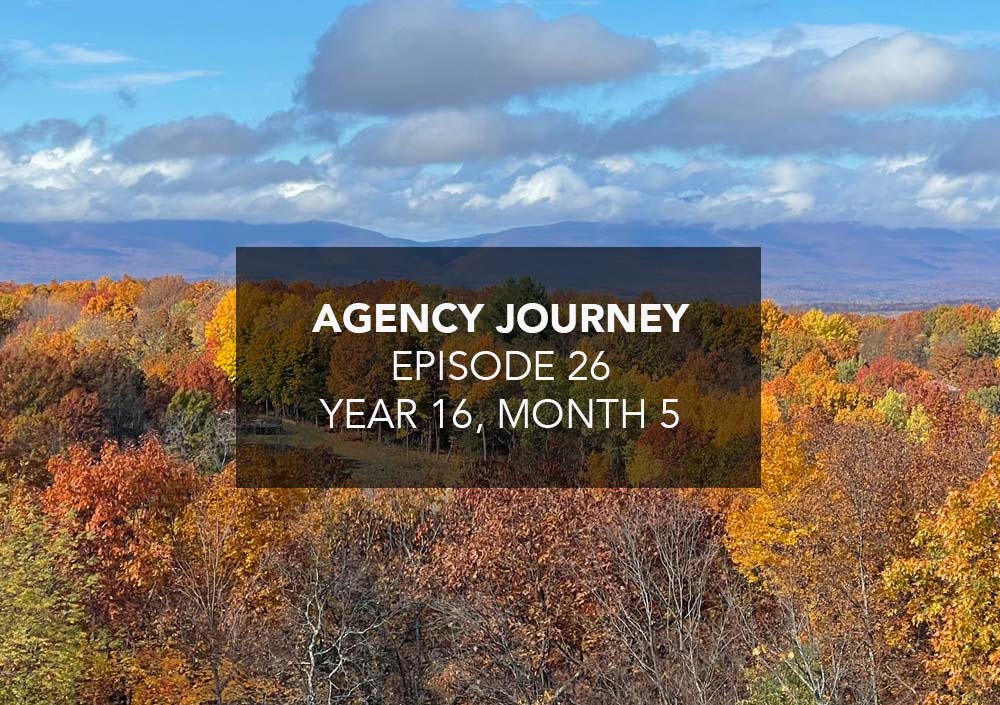October has felt like an extra-long month this year. A combination of lots of personal travel, lots of in-person meetings with different people, changing routines with my family, and being sick a couple of times seemed to stretch each week out and demand extra energy and activity. All in all, it’s been a great month with a lot to reflect on.
About Agency Journey: This is a monthly series detailing the happenings at my agency Barrel, founded in 2006. You can find previous episodes here.
Highlights
Q4 Barrel Partners All-Day and Barrel Holdings Meeting + Dinner
We held our quarterly Barrel partner’s meeting in early October at the office. We spent the bulk of the time on two books we read in preparation for the meeting: Junk to Gold by Copart founder Willis Johnson and Execution: The Discipline of Getting Things Done by Ram Charan, Charles Burck, Larry Bossidy. These were two very different books – one a memoir by a freewheeling entrepreneur with an amazing rags to riches story and the other a very traditional business book with corporate case studies. We all enjoyed reading both and drawing lessons from these that resonated with us and applied to Barrel. As we usually do, we posted takeaways and quotes from favorite passages on a large Figma board. This session yielded a lot more notes and discussion than usual, which was a good sign, meaning that the books resonated deeply with each of us.
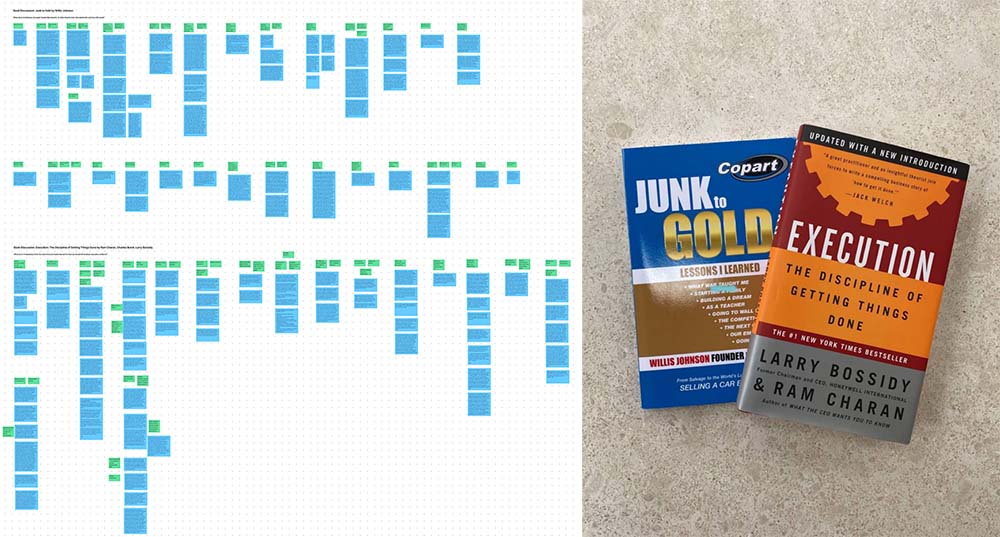
We enjoyed our reading for the quarterly meeting and generated quite a bit of notes and themes together during our book discussion. (Book photo by Lucas)
The big takeaway from Junk to Gold was to really embrace an entrepreneurial spirit and be unafraid to be opportunistic, trying new things, making deals, or being creative with products and services to win customers and grow the business. Seeing this theme play out over and over the course of Johnson’s business career was really inspiring.
In Execution, we each had slightly different takeaways that mattered most to us. Lucas drew a great deal of inspiration around the people piece, especially around performance management and hiring. Wes saw the principles of execution applying really well to project-level execution and getting the team to plan more thoughtfully with projects. Sei-Wook and I were especially inspired by the operating plan aspects, especially the depth of planning that one could engage in to have a realistic view of the present and the gap that needs to be filled in the future. We agreed that we would invest quite a bit of effort doing a better job of forecasting for next year and putting together a more robust operating plan.
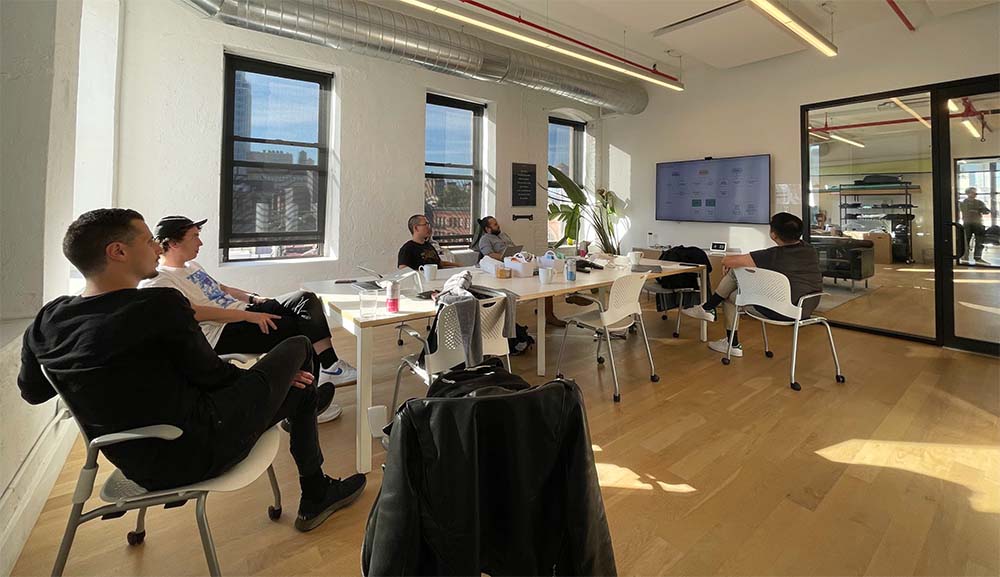
We held our quarterly Barrel Holdings meeting to review the results of Barrel, Vaulted Oak, and BX Studio for the previous quarter and outlook for the new one.
After our Barrel-focused session, we were joined by Jacob of BX Studio and Jason of Vaulted Oak for our quarterly Barrel Holdings checkin. Jacob and Jason each presented the past quarter’s performance for BX and Vaulted Oak, respectively, while Sei-Wook presented the results for Barrel. The great news was that Q3 2022 was a profitable quarter for all the companies. It was Barrel’s 2nd profitable quarter in a row after a string of negative quarters. BX showed very strong revenue growth in Q3 with an impressive string of new business wins. Vaulted Oak showed its stickiness and long-term value with a growing base of recurring revenue. We asked each other questions and shared thoughts on opportunities for continued growth in Q4. We all talked about the need to keep eyes on costs and to beware of economic headwinds that may slow business growth in the coming quarters. Nonetheless, the mood, given the strong Q3, was very optimistic.
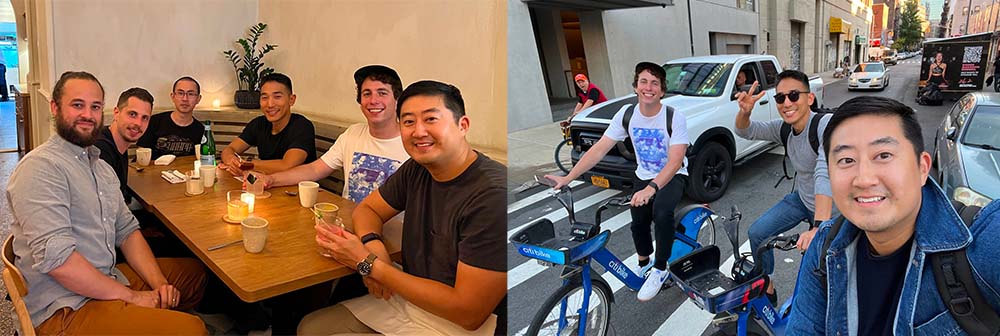
We enjoyed a leisurely ride via Citibike to Llama San where we had a great group dinner.
We concluded the day with a fun and delicious dinner at Llama San in the West Village. The weather was so perfect that we opted to ride Citibikes over from the office.
Barrel Retreat in NYC is a Success
We brought together nearly 30 people for our inaugural Barrel Retreat in New York City. The Barrel partners and Allison scrambled until the last minute to ensure everything was in place and good to go, and overall, the entire experience exceeded my expectations and went as smoothly as it could go.
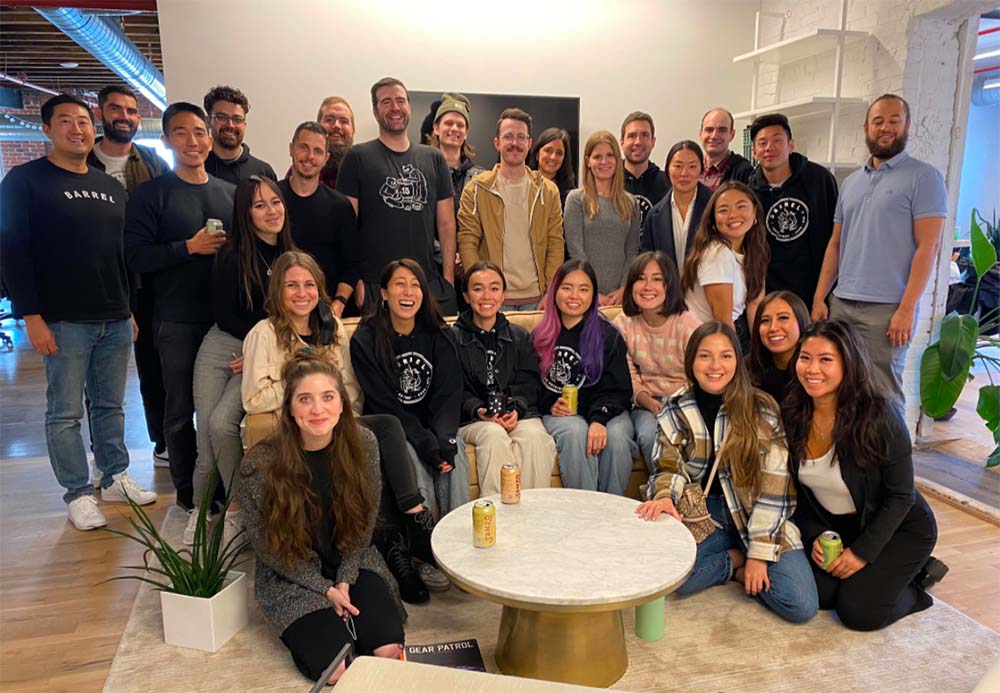
It was awesome to have the full team come together in-person for our first annual Barrel Retreat.
The one unfortunate aftermath of the event was that nearly a third of us got Covid and suffered over the weekend and into the next week. Hearing stories from others who’ve done team gatherings and also conference travel, it seems like a percentage of people getting Covid is an inevitable outcome for these types of group get-togethers.
The point of the retreat was to bring people together in-person to hang out, get to know each other, and deepen relationships by sharing memorable experiences. I think to that end, we achieved our objectives. I won’t rehash the entire agenda of the retreat (check out Lucas’s recap about our retreat, which includes the full retreat agenda), but I’ll call out a few of my favorite highlights:
Team-Building Activity: Comfort Zones

The Comfort Zones group activity led to a lot of great discussions and sharing among team members. Highly recommend as a team-building activity.
One of the group activities we did as a team was called Comfort Zones. We split into 3 groups of 8-10 people. Each group had their own part of the office where we marked three different “zones”: Comfortable, Challenging, Fearful/Anxiety-Inducing. We had facilitators for each group call out an activity like “rock climbing” or “cooking” and had people step into the zone they felt was appropriate for how the activity made them feel. After a round of doing this with several random activities, we did a round where we called out “public speaking” and went around the room to have each person talk about why they chose their respective zone. We did this again for “telling bad news to a client”. It was fascinating to hear people of different disciplines and levels share their reasons for choosing a particular comfort zone. There were moments of vulnerability as people shared instances where they struggled with these activities.
We then wrapped up by asking people about two more activities: asking for and receiving feedback and giving feedback. We also asked people, depending on the comfort zone they chose, to share in what instances they would find themselves in a different zone. Once again, the level of sharing and vulnerability among the groups was really impressive, and it was great to see people fully engaged with this activity.
I adapted this from an activity called Circles found in the Team Building Games YouTube channel.
Hall Des Lumières Visit
One of our sessions provided team members with the option to pick from 3 activities: rock climbing, a visit to the MoMa, or a visit to Hall Des Lumières, an immersive light show exhibit inside a historic bank building featuring the works of Gustav Klimt. Hall Des Lumière also happens to be a client of ours and we had helped launch their website earlier in the year.
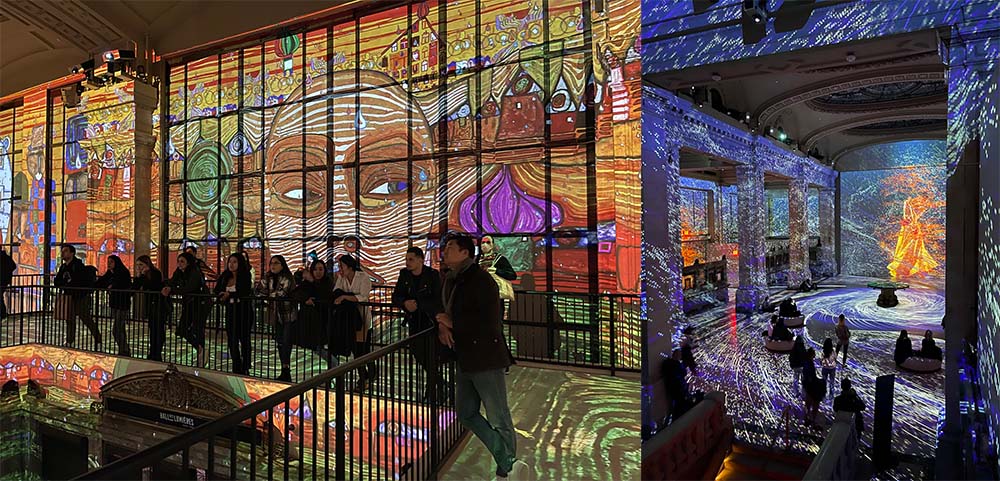
We enjoyed the Hall Des Lumière exhibit featuring the works of Gustav Klimt.
I joined the Hall Des Lumières group and got to experience the exhibition firsthand. It was a really impressive setup inside a gorgeous building. Seeing art animated and brought to life with music helped give me a new appreciation for Klimt’s work. It’s an interesting medium to recast famous artists’ works in ways that feel more intense and dramatic.
NYC Selfie Challenge Scavenger Hunt
One of our goals coming into the retreat was to give first-time New York visitors a chance to see some really cool aspects of New York City without it being too touristy. On the last day of the retreat, we unveiled the final team activity: a selfie challenge scavenger hunt where 5 teams were given a list of 20 “themes” to find and take selfies with. The activity required some strategic planning and creativity to figure out how to hit up all the places in the allotted time.

For our last group activity, we had 5 teams go around NYC taking selfies of different NYC-themed activities and landmarks.
All the teams went at it in full force and it was fascinating to see how each team interpreted the themes and chose the neighborhoods. We all convened at Freeman’s on the Lower East Side where we rented out the 2nd floor as the final spot for our retreat. Each team had to send in their photos as they took them, so that gave us the opportunity to piece together a fun slideshow to share by the time all the teams completed the hunt and made their way to the restaurant.
It was a blast and a great way to end an action-packed retreat.
Overall, the retreat is something I think we’ll definitely do again in the future. Perhaps the format may evolve as we get feedback on this first one and we’re also eager to test out different locations. I wouldn’t mind something more nature-focused with a greater degree of physical activity. Whichever way, it’s clearer than ever that for distributed teams, periodic in-person gatherings are a must.
Shopify Unite and SoDA GMM
Our CTO Wes, Director of Software Engineering Scott, and Software Engineer Miguel went to Shopify Unite in Toronto this month. They met up with various partners in the ecosystem, including those that produce our most frequently recommended apps to clients. They also caught up with other agency folks as well as our contacts at Shopify. I think trips like these are always worthwhile for us to get a sense of what others are up to, how people are thinking about the new features and changes coming from Shopify, and what challenges and issues others doing similar work as us are dealing with. We still remain believers that Shopify will continue to be a worthwhile ecosystem to be a part of, and that we’ll get more and more opportunities with established brands who’re looking to replatform to Shopify or to redesign and rebuild their existing Shopify sites.
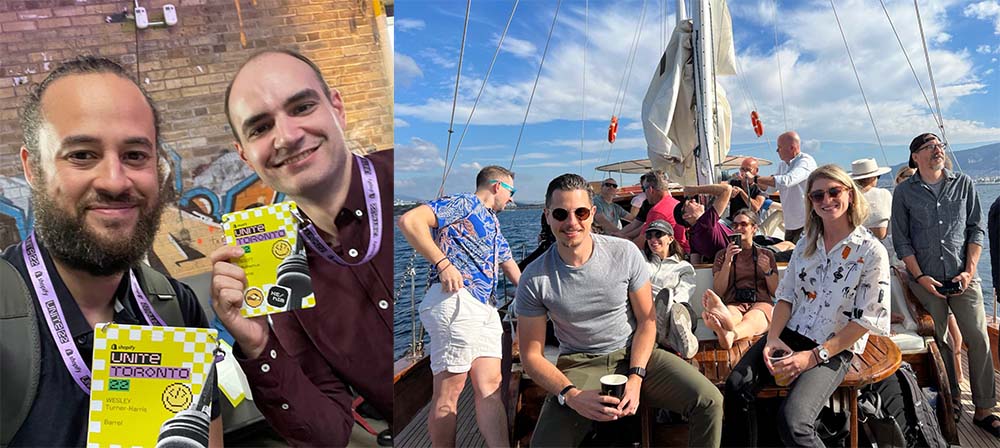
Left, our CTO Wes and Director of Software Engineering Scott attended Shopify Unite in Toronto. Lucas, right, with his wife Dana, went to Greece to attend the SoDA General Member Meeting.
Our CXO Lucas was off in Athens, Greece this past week for the General Member Meeting of SoDA, an association of digital agencies that we’ve been a part of for quite some time. Both Sei-Wook and I found it difficult to travel to Europe with our respective family situations in the same month we had our team retreat, so we opted to attend a different conference in Atlanta. Unfortunately, we both got Covid so we had to bail on the Atlanta-based conference (The Mind Your Own Business (MYOB) Conference for creative firms). Fortunately for Lucas, he came away from the retreat without Covid and had a great time in Athens, connecting with other agency leaders and representing Barrel. Sei-Wook and I were very happy to encourage this opportunity for Lucas. As a talented young designer who joined us nearly ten years ago to now being a partner, respected leader, and increasingly the key rep for Barrel with clients and industry folks, Lucas’s journey to his role as CXO has been quite impressive. We’re super proud of him and grateful we get to work with him every day.
New Business Wins and a Critical Launch
I mentioned in last month’s episode that we needed to win at least 4 new client projects to make up for a weak Q3 of sales. As of this writing, we’ve signed and kicked off 1 new client project (a science-based skincare brand) and got verbal approval on another significant new client project (in the publishing space). We also signed a new piece of work with an existing client but for another brand which will start out small this quarter but could turn into something much bigger. If we can sign the one we got the verbal offer from and then land a couple more deals, we’ll be in good shape to end the year strong.
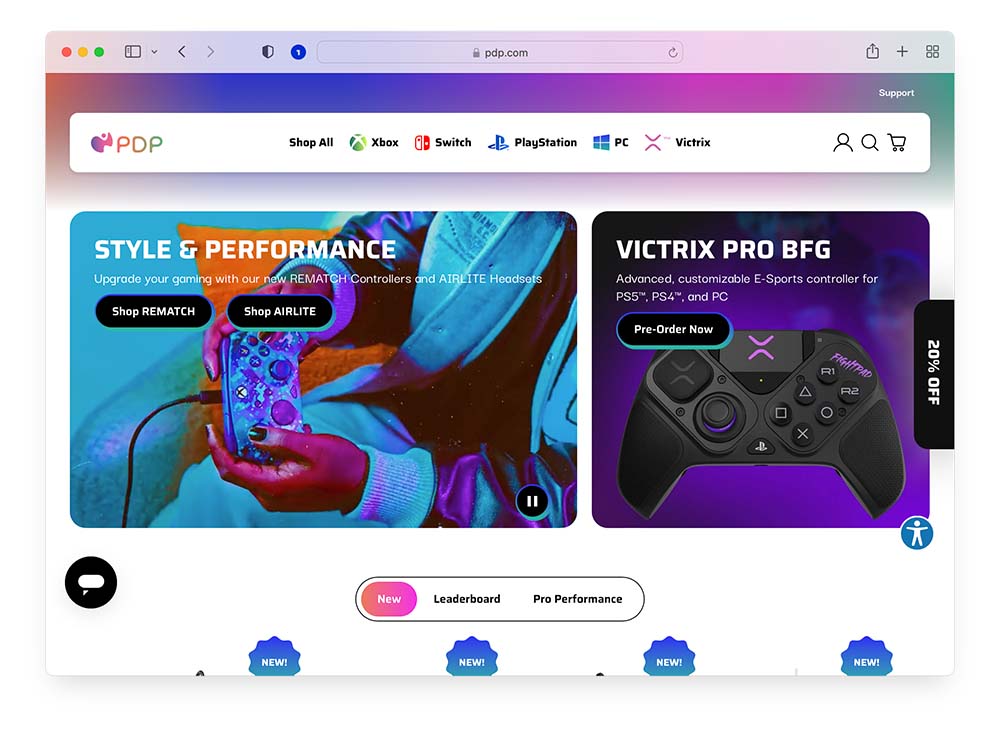
We were able to successfully launch a new website for our client PDP.
I also mentioned last month that we needed to launch two very time-critical client websites with no quality issues. We did end up launching the website for Performance Designed Products (PDP), a popular maker of video game controllers, in late September. We had some last minute issues with redirects that needed extra attention to quickly address, but overall, the site did launch without any major quality issues and we’re working to release subsequent phases of the site. This was a really tight-turnaround project that required a full-on sprint from all disciplines, and one where tight scope management and client comms played an important role in keeping things from going off the rails at any point. We now have one more very time-critical website launch coming up which I’ll share at the end of November.
Top of Mind
Tightening the Screws on Our Processes
With just two months to go in 2022, I want to finish the year with a strong emphasis on a theme that’s been top of mind: focus on the basics. I revisited this theme in the August episode and laid out the key components of our business that drive results. I wanted to highlight a few specific areas where we are continuing to refine and improve the way we collaborate, document, and execute on the work.
New Business: Defining Requirements, Estimating, Pricing, and Writing SOWs
We’ve gone through dozens of iterations over the years in how we gather and define requirements for new projects, how we estimate against these, how we then price them in our proposals, and, if we do win, how we ultimately write out a statement of work (SOW).
As we’ve become more disciplined in doing project debriefs and also involving discipline leads and partners in the new business process, more and more learnings have filtered through to the ways in which we engage with prospective clients to learn more about their needs, their current situation, and the opportunities they see for their business. We’ve become a lot more adept at gathering and defining requirements, with each completed project reminding us to not skip on certain details upfront to avoid later headaches. This has meant that the business development process has become more and more thorough and detailed, allowing us to be better prepared for when the work actually begins.
Estimating is still a tough challenge and one that we haven’t exactly cracked. There are many factors to estimating. Sometimes, we’re not 100% sure who will be staffed on a project, so that leaves some variance on how to estimate the work. For example, if we know that a senior designer is on the project, then the number of hours they’ll need may be much less. If we staff a fairly new designer who is still getting used to our processes, this person would then have to pair up with another team member for support and oversight, which could require more hours and also extend the project timeline. There are also client considerations – if we believe that a particular client will require more frequent communication and wrangling of multiple stakeholders, then we are likely to buffer the hours needed by our account lead and project manager. Even with these educated guesses, it’s likely that staffing could change in the middle of a project, unforeseen challenges can pop up with the client, and whatever estimates we had to start may differ in the end by as much as 20-30% for certain roles. The key is to have enough slack in the project so that overall, the aggregate amount of time and energy spent on the project comes in much closer to our initial estimates.
One approach we’ve found helpful is to reference past projects of similar scope and to see how the actual hours broke down. It helps to have at least 3-4 samples so that we’re not influenced by just a single project, which could have had unique circumstances that impacted the final hours. But if you look over a larger sample size, it’s possible to see lower and upper ranges and find a median that feels reasonable. It’s an inexact method but given the data set we currently have, it’s been better than nothing. We use these past projects to inform how we should estimate the project and to both cut back where we’ve padded too many hours or to pad where we’ve been too optimistic.
We estimate primarily to set a cost ceiling and to have an understanding of what it will take to get the project done. This doesn’t necessarily drive price, because price is usually driven by our initial conversations with the prospect around their budget and our guesses around the value of this initiative to their business. However, if the budget happens to fall below our estimates, then we know we’re not going to be a good fit, so we have general ranges where we know the budgets will be sufficient enough to cover costs and provide us with a profit. Where it gets super tight, we’ll do our best to hit at least a 40% project margin, but ideally, we are able to price in a way that exceeds 50%. For the type of work we do, where there is a great deal of customization around the final product and the services around it, we treat pricing as a careful dance that, if done right, can yield a win-win situation where the prospect feels like they’re getting great value on their investment and we feel like we’re compensated well for our expertise.
I think when sales are slow or we’re feeling less confident in our ability to win, we tend to lean back on a cost-plus model of trying to eke out a 40% margin on top of our cost estimates. This is something we need to continue to resist and transcend beyond with better marketing and qualification of prospective deals that allow us to work with brands that have adequate budgets to support the resources we bring to our projects. The way to tighten the screws on pricing is to stay vigilant in the conversations we have with prospective clients. A few approaches we’ll lean on repeatedly are:
- Ensuring we anchor high on our budget ranges so prospects are not surprised later and have a grasp of what it takes to work with us.
- Exploring proposals with multiple options that can more effectively nudge them in the direction that makes most sense for them.
- Offering alternative ways to engage (e.g. audit, design-only project, strategy session, etc.), especially in a way that allows for a quick win and a chance to build trust, which could lead to bigger opportunities later.
The project SOW is where the requirements, estimates, and pricing have all come together to turn the business development process into an opportunity to build something and make a profit. The focus for us has been to make our SOWs clear, detailed, and with enough guardrails to protect us from uncertainties. A user-friendly SOW is one that can be referenced by the project team and the client throughout the project (as a companion to a brief) and is seen more as a resource than a document of last resort for when conflicts arise. As we’ve run into issues on projects, we’ve moved quickly to highlight opportunities to improve our SOWs for subsequent projects. This could be language around certain types of features or the process to get final sign-off from the client prior to launch. I believe that as long as we do projects, there will always be refinements to make to the SOW and opportunities to add new language for future projects.
SOPs: Accessibility and Pre-Launch SEO
One of the initiatives that I’ve personally led this year is the creation of an Agency Standard Operating Procedures (SOPs) collection that cover a handful of agency-wide processes. The goal of these SOPs were not to document and centralize all of our processes. In fact, we don’t even attempt to document our project processes. Our aim was to curate a handful of key, high-leverage topics and to focus on creating simple, clear, and easy-to-follow (and update) documentation that would actually get used by our team.
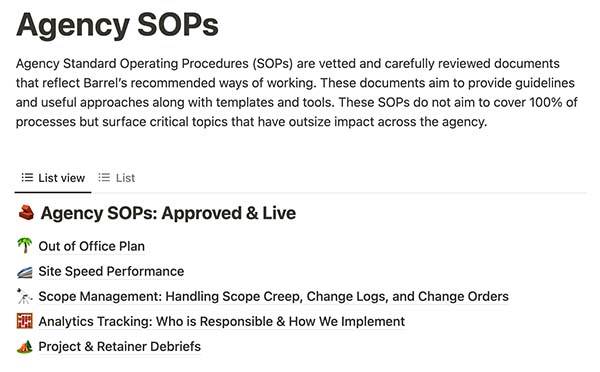
A screenshot of our SOP section in our Barrel Notion. We’ve kept posts to a minimum and will be adding at most 2-3 SOPs per quarter to ensure quality, accuracy, and overall utility.
I’ve primarily collaborated with our CTO Wes and our Account Manager Madison to draft, circulate for feedback, edit, and publish SOPs for the past 2 quarters. We’ve been able to roll out SOPs on topics that have traditionally been thorny gaps in our processes, namely our approach to website analytics tracking and our approach to site speed performance. These two SOPs helped to define, once and for all, who was responsible for what tasks on projects, what our agency POV was, and how to deal with specific client questions & situations. It’s been really gratifying to see these areas addressed after they caused us countless headaches with clients and a great deal of internal frustration among team members.
Other topics that we’ve published SOPs already are scope management and issuing change orders, project debriefs, and out of office plans for people taking extended PTOs.
Next up are two areas that, like analytics and site speed performance, have caused some confusion and frustration on projects: accessibility and pre-launch SEO. I’m currently working with Wes and Madison to draft these and the goal is to have them published by the end of the year. The accessibility piece is already feeling like it’s in place because we’ve done the work of clarifying language on what we support and what we require of clients in getting 3rd party auditing done. This has already made its way to our SOW language. The pre-launch SEO SOP will require more work. We’re taking a very narrow definition of SEO for this purpose, related primarily to how we set up the website to be best optimized for Google to crawl and index the pages. There’s a lot of noise that we want to cut through and to ensure that our team knows how to speak confidently on our SEO approach while also deferring to partners on other SEO topics like content marketing.
I’ve thoroughly enjoyed the SOP work because it truly feels like focusing on the basics. A lot of these things are, on its face, simple and obvious things that seem easy and quick to take care of, but without the right processes and clearly assigned responsibilities, you realize that so many things can fall through the cracks and either get missed or get done poorly.
As we continue to publish these SOPs, I’m also very aware that they’ll only be as good as their utility on the last project. The moment people lose faith in the accuracy or utility of the SOP, things will start to fall apart quickly. This is why I think we’ll keep the total number of SOPs as limited as possible and then establish systems to do periodic reviews along with updates and training sessions to ensure these stay living and breathing documents that help team members avoid mistakes in their work.
Shared with Partners
“Charles Darwin wrote, “It is not the strongest of the species that survive, nor the most intelligent, but the one that proves itself most responsive to change.” The growth of your company, then, is its change. Your role is to go with it, to be with it, to share the joy, embrace the opportunities, meet the challenges, learn the lessons. Remember, there are three kinds of people: (1) those who make things happen, (2) those who let things happen, and (3) those who wonder what the hell happened. The people who make things happen are masters of change. The other two are its victims. Which type are you?” (Michael E. Gerber and Fred G. Parrish, The E-Myth Chief Financial Officer)
There are signs that the economic environment may not be great in the coming months and maybe years. While we are optimistic about the progress we’ve made as a business, I know that if unforeseen changes and disruptions happen to the business, we’ll need to react quickly and adapt to ensure our survival. It all sounds very stressful and unpleasant, but better to ready our mindset for it versus hoping it doesn’t happen.
“A very powerful resource position produces profit without great effort, and it is human nature that the easy life breeds laxity. It is also human nature to associate current profit with recent actions, even though it should be evident that current plenty is the harvest of planting seasons long past.” (Richard Rumelt, Good Strategy Bad Strategy)
Love this quote, it’s a bias that plays out over and over again in the course of business history. I also believe that we’re doing the “planting” that will indeed lead to bigger harvests in the future.
“Understanding the distinction between service and hospitality has been at the foundation of our success. Service is the technical delivery of a product. Hospitality is how the delivery of that product makes its recipient feel. Service is a monologue—we decide how we want to do things and set our own standards for service. Hospitality, on the other hand, is a dialogue. To be on a guest’s side requires listening to that person with every sense, and following up with a thoughtful, gracious, appropriate response. It takes both great service and great hospitality to rise to the top.” (Danny Meyer, Setting the Table)
There’s a great deal to learn from the concept of hospitality when it comes to client services. I wrote about this previously when I discussed client experience vs. quality of work.
“The leader who executes often does not even have to tell people what to do; she asks questions so they can figure out what they need to do. In this way she coaches them, passing on her experience as a leader and educating them to think in ways they never thought before. Far from stifling people, this kind of leadership helps them expand their own capabilities for leading.” (Larry Bossidy, Ram Charan, Charles Burck, Execution)
Great reminder to lead with questions versus trying to tell people what to do. When I’m feeling patient and calm, I find it easier to lead with questions, but when I’m a bit stressed, frustrated, or feeling impatient, I know I default to more prescriptive language, which I’m sure isn’t the best way to lead.
“Build a team culture around labor productivity. Communicate your expectations to your team and hold them accountable. Do not expect to use incentive pay as a substitute for leadership and management.” (Greg Crabtree, Simple Numbers, Straight Talk, Big Profits!)
I think it’s natural for leaders to want to jump right to rewards and “upside” as a way to drive performance, but I love the reminder that having clear expectations and strong accountability can create a culture that gets you the desired results. The rewards can be layered on top but should not be the starting point.
